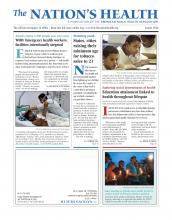Patients with melanoma who check regularly for abnormal moles find more new cancer when both they and their partners are trained to spot them, according to a recent study.
The research was published online June 29 in JAMA Dermatology.
Skin check partners can include marital partners, romantic partners and good friends, said June Robinson, MD, a research professor in dermatology at Northwestern Medicine. Partners of patients with melanoma can be crucial in identifying problem moles, as people who have been diagnosed with one melanoma have 10 times the risk of developing a second one, she added.
Over two years the study looked at 494 people who previously had melanoma. In 395 of those people, their partners were given educational tools to help check for suspicious moles every four months. The remaining 99 people made up a control group of people with melanomas but whose partners were not given educational tools.
Among the tools were skin self-examination laminated education cards, which informed patients with melanoma and their partners how to analyze moles for their border, color, diameter and evolution in their features. The cards also explained how to score the severity of a mole and suggested when a patient should get it examined by a health professional. For border, color and diameter characteristics, patients and partners scored each on a scale of 1 to 3. Scoring a three in each warranted a doctor’s visit within two weeks.
“If you assess the three things you’re looking at, you’ve made a decision and a commitment, and the partners work together in making that decision,” Robinson said. “It’s not easy deciding whether a border is irregular or not.”
In the trained sample of study participants, 13.4 percent of patients developed a new melanoma, and their partners found 43 melanomas. None of the control group patients and partners found any melanomas, but health care professionals identified 16, the study found.
Robinson said she expected the awareness from the regular checks to increase the number of doctor’s visits, but was surprised when it did not.
“By allowing people to manage the process of skin checks, they become in control over the disease process,” Robinson told The Nation’s Health. “There’s a decrease in anxiety about every little thing found. They feel comfortable watching and waiting to see if something has changed and if nothing has changed it saves them a visit to the doctor needlessly.”
For more information on the study, visit http://archderm.jamanetwork.com/article.aspx?articleid=2529573. For more information on how to check for suspicious moles, visit www.cancer.gov/types/skin/self-exam.
- Copyright The Nation’s Health, American Public Health Association









